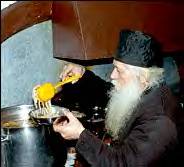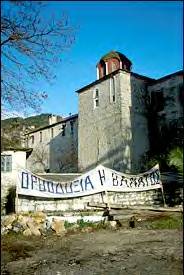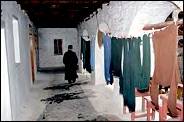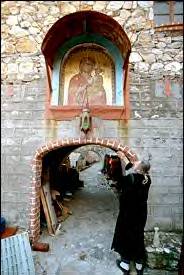 |
  A monk preparing a meal at the A banner at the fortress-like cloister declares Esphigmenou monastery in northern Greece. "Orthodoxy or Death." Greek Monks Guard Faith and Sacred Ground By FRANK BRUNI MOUNT ATHOS, Greece, Feb. 4 — The rebel forces occupying a rugged cove on the Aegean here number more than 100, and they will not budge. They have enough food to last them two years, given that they favor rudimentary meals, sometimes just once a day. They have enough faith to sustain them through utter isolation, which is actually their preferred lifestyle. They have munitions, of a sort. "There are 300 bullets here," said Father Methodius, their fearless leader, as he lifted his weapon in the air. It was a roped prayer chain of precisely that many knots, and his battalion of black-robed, bushy-bearded monks had plenty more. This remote, mountainous peninsula in northern Greece, where 20 Orthodox monasteries lie beyond the reach of paved roads and most of the intrusions of everyday life, has become the unlikely setting of a holy war, or at least an extremely nasty spiritual spat over who says prayers, and which ones. After decades of defying and vilifying a succession of patriarchs of Orthodox Christianity, Father Methodius and the roughly 110 other denizens of the ultra-conservative Esfigmenou monastery here have been ordered out of their fortresslike cloister and off Mount Athos. They were supposed to be gone by Jan. 28. They are not, and they say they will die before they leave, a pledge underlined by the message on a banner that hangs by the entrance. It reads, "Orthodoxy or Death." The local police have restricted the movement of supplies and visitors into and out of the Esfigmenou monastery and have been empowered to prevent any Esfigmenou monks who step off Mount Athos from returning. Representatives from other monasteries on the peninsula vow to get rid of them, by hook, crook or judicial fiat. The dispute is before Greece's highest administrative court. "We don't intend to shoot them or use force against them or even give them the pleasure of making them look like martyrs," said Father Ioannis, the chief secretary of the council of monastery representatives that supervises the daily affairs of Mount Athos. But, Father Ioannis added, "They have to understand that they cannot be the Taliban" of the peninsula. The slender, 31-mile-long finger of land has long been revered by Orthodox Christians, and it remains a semi-autonomous state, answerable in a fashion to the patriarch and to the Greek Foreign Ministry. A few dirt roads cross its steep slopes and only ferry service connects it to the mainland. Visitors need special permits, and women are not allowed. Even female livestock are kept away. But its tranquillity has been sullied for at least 30 years by a brewing — now boiling — debate over how prayers are said, and with whom. After Orthodox leaders began a dialogue with the Roman Catholic Church, the monks of Esfigmenou, who viewed that as a betrayal of the religion, stopped mentioning one ecumenical patriarch after another in devotions. They also stopped praying with monks who did not take the same course. "They shout at us, calling us traitors," Father Ioannis said. They refused to repent. Finally, in November, the current ecumenical patriarch, Bartholomew, branded them schismatics and therefore squatters on sacred ground. They were later served with the eviction order. In their court appeal, they claim a violation of their freedom of religion. But their statements to reporters go beyond that, describing a pitched struggle between encroaching modernity and aged tradition, hedonism and asceticism, in which they represent the last surviving vestige of how things should be. They are an interesting lot, steeped in old rituals and mystical convictions. They still follow the Julian instead of the Gregorian calendar and cling to a Byzantine method of telling time, regularly resetting their clocks so that the dividing line between one day and the next is when the sun sets. They say when an Esfigmenou monk dies, his body does not go into rigor mortis, but remains flexible forever. "It is a miracle," said Father Gregory, one of the monks. Father Gregory also said the left leg of Mary Magdalene is under lock and key in the monastery's church, and has never decomposed. "You can see the nerves," he said. They live without electricity, mirrors, hot water for bathing or almost any other creature comforts. But they say that some of the other monasteries have gone so far as to install private bathrooms, computers and Internet access. "These things do not benefit a monastic life," said Father Neophytos, another of the Esfigmenou monks. They also refuse to take European Union cultural funds for the restoration of monasteries, but note that others on Mount Athos accept the money. They say outside agitations for an end to the peninsula's ban on women and a beginning of tourist resorts cannot be far behind. Father Ioannis dismissed all of that as melodramatic nonsense from "people who lack prudence and sane mental understanding." The Esfigmenou monks do seem to exaggerate at times. When a reporter encountered one on the ferry to Mount. Athos and asked him how he would get past the police and back into the monastery, he said: "I climb. I fly." Minutes later, when the ferry docked, he walked slowly and calmly to a waiting truck. There was not a police officer in sight. The Esfigmenou monks say the police have relaxed their vigilance because of news media attention, but still watch them from the surrounding hills, ready to pounce. Greek officials and a spokesman for the patriarch say that will never happen, which suggests that the standoff could go on for a while. "I'm not concerned," said Father Amartolos as he stood guard this morning at the entrance to the Esfigmenou monastery, his fingers tying knots in a new prayer chain. "I'm in the embrace of Mary, the mother of Jesus," Father Amartolos said. "The way she holds Jesus, she holds us."
The monks live a simple life. A monk lights a lantern at an
|

